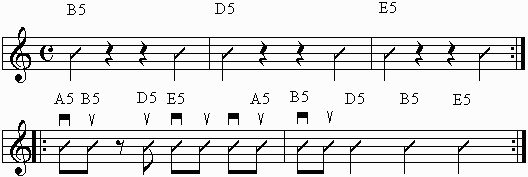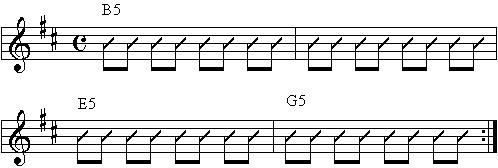 |
|
Lesson 13
|
||||||||||||||||||||||||
|
In this lesson we will look at extending 2 of our scale positions and work on shifting. We will also learn our D major inversions on strings 1 2 3 and compare to D minor on strings 1 2 3. Power Chords - Veruca Salt Improvising - Veruca Salt - D major (2 or 3 positions) D major 7th arpeggio in 2nd Back to Lesson 12 |
|
|||||||||||||||||||||||
|
Scales - D Major in 2nd Position |
||||||||||||||||||||||||
|
2nd Position
D Major Scale Extended  |
2nd Position
D Major Pentatonic  |
|||||||||||||||||||||||
|
2nd Position
D Major Scale  |
This scale to the left should look familiar to you. This is the D major scale we learned in Lesson 6 and is our open (or 1st) position C scale form moved up a whole step. The scale to the right is the same scale form extended in the whole position. If you play from B to B you will be playing a B Minor scale. The scale to the far right is the same scale missing the 4th and 7th degree and therefore called a Pentatonic scale. D major pentatonic or B minor pentatonic. The scale forms below are the same as the on the right. |
|||||||||||||||||||||||
|
2nd Position
D Major Scale Extended  |
2nd Position |
|||||||||||||||||||||||
|
Remember you can find any major keys relative minor by going to the 6th degree of the scale or going down a minor 3rd interval. So in the case of the key of D major, if you go to the 6th degree of the scale or go down a minor 3rd you will get B. So the key of D major and B minor both share the same notes and have 2 sharps (F# and C#) Review Lesson 5. D major scale in 4th Position |
||||||||||||||||||||||||
|
This D major scale should look familiar. This is our 2nd position C major scale form from Lesson 4 moved up one whole step. Note the fretboard in the middle (and below) is the same scale but extended to play all of the notes from the D major scale in 4th position. It is considered a 4th position scale because your 1st finger looks after the 4th fret, 2nd finger looks after the 5th, 3rd finger the 6th and little finger looks after the 7th however, you will have to stretch your index finger to get the 3rd fret G's . The fretboard on the far right is the 4th position D major pentatonic scale. We could also call it a B minor pentatonic scale. |
4th Position D Major Scale  |
4th Position
D Major Scale Extended  |
4th Position
D Major Pentatonic  |
|||||||||||||||||||||
|
4th Position |
||||||||||||||||||||||||
|
Parallel Minor D Major 1 2 3 4 5 6 7 D Minor 1 2 b3 4 5 b6 b7 Notice that D minor has one flat and is the relative minor of F major from lesson 10
|
||||||||||||||||||||||||
|
Arpeggio - D major 7th in 2nd Position |
||||||||||||||||||||||||
|
D |
To the left is the D arpeggio we did in lesson 6 and the fretboard on the right is a Dmajor7th arpeggio with the 7th degree of a D major scale added. The interval between the root and 7th is 11 half steps and is called a major 7th. |
Dmaj7 |
||||||||||||||||||||||
|
D Major Triad Inversions on Strings 1 2 3 |
||||||||||||||||||||||||
|
D
2nd Inversion 
|
D |
D |
||||||||||||||||||||||
|
Diatonic triads in the Key of D major or B minor - strings 1 2 3 Note all these triads are in 2nd inversions. When we learned the F diatonic triads in lesson 11, they were all in root. |
||||||||||||||||||||||||
|
D

|
Em

|
F#m

|
G

|
A

|
||||||||||||||||||||
|
Bm

|
C#dim

|
|||||||||||||||||||||||
|
Improvising So for this improvising lesson, let's focus on connecting our 2nd and 4th D major and D major pentatonic scales. We could also call them B minor and B minor pentatonic scales. When connecting the different scale forms try to shift with a finger that plays in both positions. For example, if I was going to shift on my low E string I would use my little finger to slide from the A to B. Find a couple shifts you like and practice using just those. The first finger on the 3rd and 4th string work well for shifting. |
||||||||||||||||||||||||
| Try this: play your 2nd position scale up and down a couple times and then use your 1st finger to slide from the A to B on the 3rd string. Play your 4th position scale up and down and then shift back to 2nd using your 1st finger again. |  |
|||||||||||||||||||||||
|
Note: you will have more shifting options with the full major scale as compared to the pentatonic. The progression below will also work well with the above scales:
|
||||||||||||||||||||||||
|
Midi File - of above progression. Right click to download and play in any midi sequencer so you can adjust tempo. |
||||||||||||||||||||||||
|
Improv even more: You can find a one chord (Dmaj7th) jam by clicking here.
Practice Routine New Material D Major in 2nd and 4th (pentatonic and extended) D major and minor inversions on strings 1 2 3 D major and major 7th arpeggio in 2nd position.
Things You Should be Reviewing (as often as possible) Scales: Chords: Arpeggios:
|
||||||||||||||||||||||||
| Vancouver British Columbia Canada 604 357-3551 http://www.musiclearning.com |








